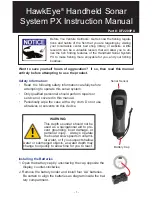
SYSTEM PERFORMANCE AND DATA TYPES
SeaBat 7125 SV2 Operator‟s Manual
Page 117
July 25, 2011
Version 3
7.1 Beam Modes
16
Beam mode selection is made on the fly via the sonar control tabs (see
section 5.7.1.3
Normal mode:
In this mode the operator is presented with a standard wedge
of 140° and GUI controls. Selection (depending on licensed features) may be
made between Minimum Beams, Intermediate, and Best Coverage (see also
200kHz
o
Minimum Beams: 140 EA
o
Intermediate:
320 ID
o
Best Coverage:
320 ED
400kHz
o
Minimum Beams: 240 EA
o
Intermediate:
512 ID
o
Best Coverage:
512 ED
Wide mode:
In this mode the system is started with a 165° wedge.
200kHz
o
Wide:
512 EA
400kHz
o
Wide:
512 EA
Flex mode:
In this mode the system is started with a 140° wedge and an
alternative beam distribution is used which concentrates the majority of beams
into a central sector.
200kHz
o
Flex:
321
400kHz
o
Flex:
511
7.1.1 Minimum Beams
Minimum Beams is intended to provide full swath coverage using the minimum number
of beams required to fill the selected sector using the natural beam width and spacing.
Spacing between the beams is equiangular.
7.1.2 Intermediate
Intermediate mode is designed for general purpose survey operations and provides
high-density soundings over the entire swath.
7.1.3 Best Coverage
Best Coverage provides equally spaced soundings across the entire swath and should
be used when it is critical to maintain a certain number of hits per cell across the
maximum possible swath.
16
Intermediate, Best Coverage, Wide, and Flex modes are available with the Efficiency feature
Summary of Contents for SeaBat 7125 SV2
Page 2: ...This page intentionally left blank...
Page 211: ......
































